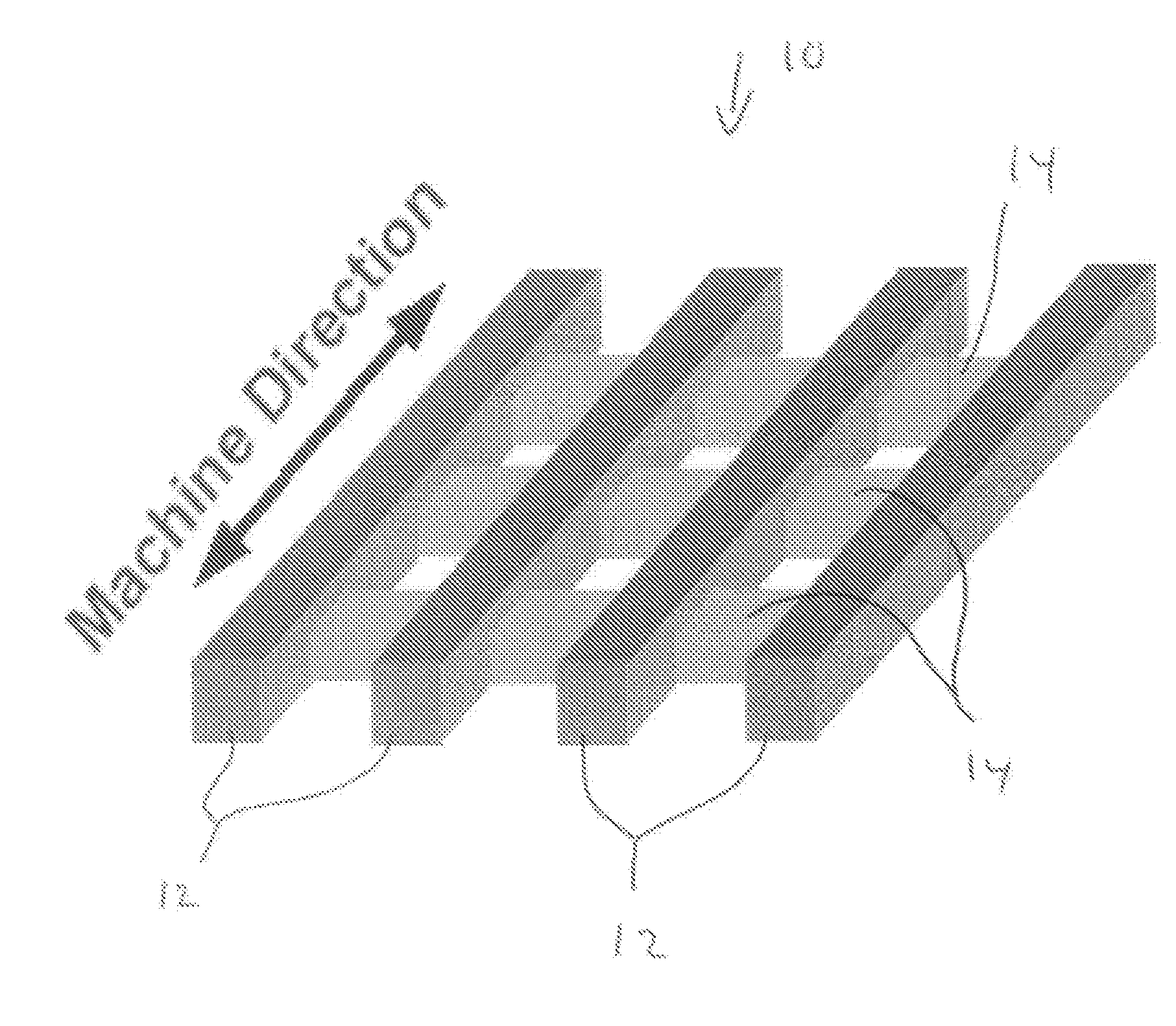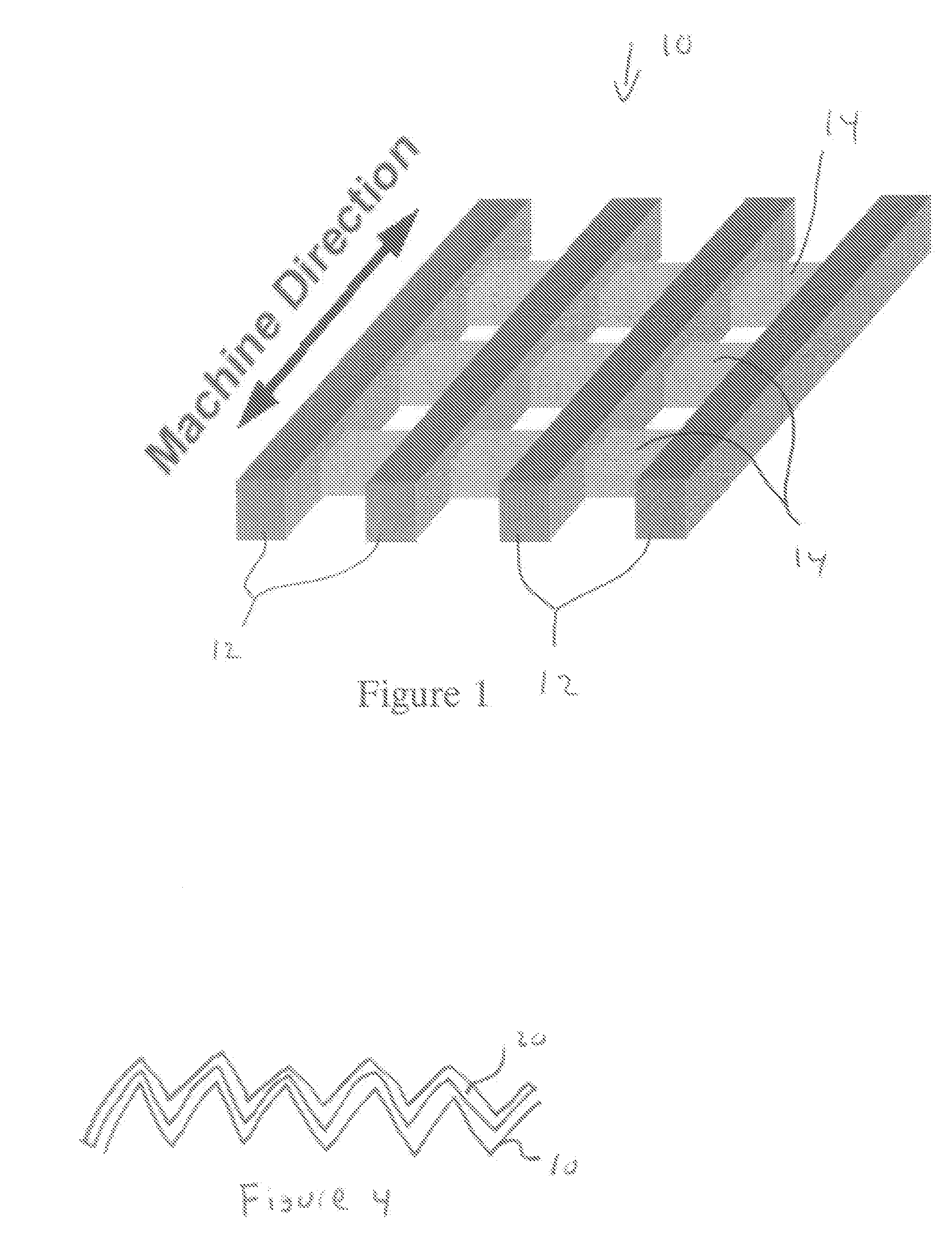Hdpe biaxially oriented netting
a technology of hdpe and oriented netting, which is applied in the direction of weaving, separation process, filtration separation, etc., can solve the problems of difficulty in biaxial orienting and cross-direction orienting of extruded hdpe netting, and less widely available oriented hdpe netting than extruded hdpe netting
- Summary
- Abstract
- Description
- Claims
- Application Information
AI Technical Summary
Problems solved by technology
Method used
Image
Examples
example 1
[0085] An extruded netting is produced at a basis weight of 45 lbs. / 1000 sq. ft. and a total width 47 inches. The raw material composition is 100.0% Alathon® M6210 from Equistar. The extruded netting has a machine direction strand count of 21.5 strands per inch, and a cross direction strand count of 17.5 strands per inch. The extruded netting's machine direction (MD) peak strength is 1.2 lbs. / strand, and its cross-direction (CD) peak strength is 1.0 lbs. / strand.
[0086] The molecular weight of the HDPE was characterized using gel permeation chromatography (GPC). The GPC analysis was done using the following equipment and conditions: [0087] Waters Styragel colums (4 in series) [0088] Temperature=135° C. [0089] Eluent / mobile phase: 1,2,4-Trichlorobenzene [0090] Stabilizer: Santanox R@0.2% [0091] Standards: 3 n-Alkanes (283-843)+4 narrow polyethylenes [0092] Sample prep: 12 mg in 4 mL
[0093] This analysis yielded the following information on the HDPE M6210:
Average molecular weight (Mn)...
example 2
[0095] An extruded netting is produced at a basis weight of 42 lbs. / 1000 sq. ft. and a total width of 50″ inches. The raw material composition is 97.5% 35060E from Dow Plastics, 1.5% UV stabilizer and 1.0% process aid. The extruded netting has a machine direction strand count of 19 strands per inch, and a cross direction stand count of 15 stands per inch. The extruded netting's machine direction (MD) peak strength is 1.16 lbs / strand, and its cross direction (CD) peak strength is 0.80 lbs / strand.
[0096] The extruded netting is subsequently biaxially oriented by first stretching the extruded netting in the machine direction at a temperature of around 240° F., with an orientation ratio of 2.94. The netting is then immediately stretched in the cross direction at a temperature of around 240° F., with an orientation ratio of 4.11. The resulting biaxially oriented netting has 4.6 strands per inch in the MD and 5.1 strands per inch in the CD. The average MD peak strength is 1.2 lbs / strand, ...
example 3
[0097] An extruded netting is produced at a basis weight of 34.5 lbs. / 1000 sq. ft. and a total width 37.5″ inches. The raw material composition is 66.5% Alathon® M6210 from Equistar, 33% Alathon® M6030B from Equistar, and 0.5% black colorant 24000 from Standridge Color Corporation. The extruded netting has a machine direction strand count of 17.5 strands per inch, and a cross direction strand count of 16.0 strands per inch. The extruded netting's machine direction (MD) peak strength is 0.88 lbs / strand, and its cross direction (CD) peak strength is 0.59 lbs / strand.
[0098] Alathon® M6030B from Equistar is an HDPE resin with the following properties:
Melt index3.00Density0.960Average molecular weight (Mn)16,418Weighted average molecular weight (Mw)93,221Number average molecular weight (Mz)345,018Peak average molecular weight (Mp)30,704Polydispersity index (Mw / Mn)5.68
[0099] The extruded netting is subsequently biaxially oriented by first stretching the extruded netting in the machine d...
PUM
| Property | Measurement | Unit |
|---|---|---|
| weight percent | aaaaa | aaaaa |
| weight percent | aaaaa | aaaaa |
| weight percent | aaaaa | aaaaa |
Abstract
Description
Claims
Application Information
 Login to View More
Login to View More - R&D
- Intellectual Property
- Life Sciences
- Materials
- Tech Scout
- Unparalleled Data Quality
- Higher Quality Content
- 60% Fewer Hallucinations
Browse by: Latest US Patents, China's latest patents, Technical Efficacy Thesaurus, Application Domain, Technology Topic, Popular Technical Reports.
© 2025 PatSnap. All rights reserved.Legal|Privacy policy|Modern Slavery Act Transparency Statement|Sitemap|About US| Contact US: help@patsnap.com



